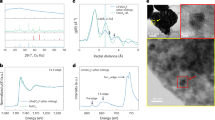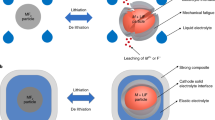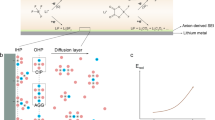Abstract
Anionic redox reactions in cathodes of lithium-ion batteries are allowing opportunities to double or even triple the energy density. However, it is still challenging to develop a cathode, especially with Earth-abundant elements, that enables anionic redox activity for real-world applications, primarily due to limited strategies to intercept the oxygenates from further irreversible oxidation to O2 gas. Here we report simultaneous iron and oxygen redox activity in a Li-rich anti-fluorite Li5FeO4 electrode. During the removal of the first two Li ions, the oxidation potential of O2− is lowered to approximately 3.5 V versus Li+/Li0, at which potential the cationic oxidation occurs concurrently. These anionic and cationic redox reactions show high reversibility without any obvious O2 gas release. Moreover, this study provides an insightful guide to designing high-capacity cathodes with reversible oxygen redox activity by simply introducing oxygen ions that are exclusively coordinated by Li+.
This is a preview of subscription content, access via your institution
Access options
Access Nature and 54 other Nature Portfolio journals
Get Nature+, our best-value online-access subscription
$29.99 / 30 days
cancel any time
Subscribe to this journal
Receive 12 digital issues and online access to articles
$119.00 per year
only $9.92 per issue
Buy this article
- Purchase on Springer Link
- Instant access to full article PDF
Prices may be subject to local taxes which are calculated during checkout








Similar content being viewed by others
References
Whittingham, M. S. Lithium batteries and cathode materials. Chem. Rev. 104, 4271–4301 (2004).
Sathiya, M. et al. Reversible anionic redox chemistry in high-capacity layered-oxide electrodes. Nat. Mater. 12, 827–835 (2013).
McCalla, E. et al. Visualization of O–O peroxo-like dimers in high-capacity layered oxides for Li-ion batteries. Science 350, 1516–1521 (2015).
McCalla, E. et al. Understanding the roles of anionic redox and oxygen release during electrochemical cycling of lithium-rich layered Li4FeSbO6. J. Am. Chem. Soc. 137, 4804–4814 (2015).
Luo, K. et al. Charge-compensation in 3d-transition-metal-oxide intercalation cathodes through the generation of localized electron holes on oxygen. Nat. Chem. 8, 684–691 (2016).
Seo, D.-H. et al. The structural and chemical origin of the oxygen redox activity in layered and cation-disordered Li-excess cathode materials. Nat. Chem. 8, 692–697 (2016).
Sathiya, M. et al. Electron paramagnetic resonance imaging for real-time monitoring of Li-ion batteries. Nat. Commun. 6, 6276 (2015).
Grimaud, A., Hong, W., Shao-Horn, Y. & Tarascon, J.-M. Anionic redox processes for electrochemical devices. Nat. Mater. 15, 121–126 (2016).
Freire, M. et al. A new active Li–Mn–O compound for high energy density Li-ion batteries. Nat. Mater. 15, 173–177 (2016).
Pearce, P. E. et al. Evidence for anionic redox activity in a tridimensional-ordered Li-rich positive electrode β-Li2IrO3. Nat. Mater. 16, 580–586 (2017).
Zhu, Z. et al. Anion-redox nanolithia cathodes for Li-ion batteries. Nat. Energy 1, 16111 (2016).
Okuoka, S.-i et al. A new sealed lithium-peroxide battery with a Co-doped Li2O cathode in a superconcentrated lithium bis(fluorosulfonyl)amide electrolyte. Sci. Rep. 4, 5684 (2014).
Ogasawara, Y. et al. Charge/discharge mechanism of a new Co-doped Li2O cathode material for a rechargeable sealed lithium-peroxide battery analyzed by X-ray absorption spectroscopy. J. Power Sources 287, 220–225 (2015).
Harada, K. et al. Electrochemical reactions and cathode properties of Fe-doped Li2O for the hermetically sealed lithium peroxide battery. J. Power Sources 322, 49–56 (2016).
Narukawa, S. et al. Anti-fluorite type Li6CoO4, Li5FeO4, and Li6MnO4 as the cathode for lithium secondary batteries. Solid State Ionics 122, 59–64 (1999).
Imanishi, N. et al. Antifluorite compounds, Li5+xFe1−xCoxO4, as a lithium intercalation host. J. Power Sources 146, 21–26 (2005).
Noh, M. & Cho, J. Role of Li6CoO4 cathode additive in Li-ion cells containing low coulombic efficiency anode material. J. Electrochem. Soc. 159, A1329–A1334 (2012).
Lim, Y.-G. et al. Anti-fluorite Li6CoO4 as an alternative lithium source for lithium ion capacitors: an experimental and first principles study. J. Mater. Chem. A 3, 12377–12385 (2015).
Kirklin, S., Chan, M. K. Y., Trahey, L., Thackeray, M. M. & Wolverton, C. High-throughput screening of high-capacity electrodes for hybrid Li-ion-Li-O2 cells. Phys. Chem. Chem. Phys. 16, 22073–22082 (2014).
Johnson, C. et al. Li2O removal from Li5FeO4: A cathode precursor for lithium-ion batteries. Chem. Mater. 22, 1263–1270 (2010).
Trahey, L. et al. Activated lithium-metal-oxides as catalytic electrodes for Li–O2 cells. Electrochem. Solid-State Lett. 14, A64–A66 (2011).
Thackeray, M. M., Chan, M. K. Y., Trahey, L., Kirklin, S. & Wolverton, C. Vision for designing high-energy, hybrid Li ion/Li–O2 cells. J. Phys. Chem. Lett. 4, 3607–3611 (2013).
Hirano, A. et al. Electrochemical properties and Mössbauer effect of anti-fluorite type compound, Li5FeO4. Solid State Ionics 176, 2777–2782 (2005).
Okumura, T., Shikano, M. & Kobayashi, H. Effect of bulk and surface structural changes in Li5FeO4 positive electrodes during first charging on subsequent lithium-ion battery performance. J. Mater. Chem. A 2, 11847–11856 (2014).
Maroni, V. A., Johnson, C. S., Rood, S. C. M., Kropf, A. J. & Bass, D. A. Characterization of novel lithium battery cathode materials by spectroscopic methods: The Li5+xFeO4 system. Appl. Spectrosc. 67, 903–912 (2013).
Gilmore, K. et al. Efficient implementation of core-excitation Bethe–Salpeter equation calculations. Comput. Phys. Commun. 197, 109–117 (2015).
Vinson, J., Rehr, J. J., Kas, J. J. & Shirley, E. L. Bethe-Salpeter equation calculations of core excitation spectra. Phys. Rev. B 83, 115106 (2011).
Mizokawa, T. et al. Role of oxygen holes in LixCoO2 revealed by soft X-ray spectroscopy. Phys. Rev. Lett. 111, 056404 (2013).
Su, X. et al. A new strategy to mitigate the initial capacity loss of lithium ion batteries. J. Power Sources 324, 150–157 (2016).
McCloskey, B. D., Bethune, D., Shelby, R., Girishkumar, G. & Luntz, A. Solvents’ critical role in nonaqueous lithium–oxygen battery electrochemistry. J. Phys. Chem. Lett. 2, 1161–1166 (2011).
Ravel, B. & Newville, M. ATHENA, ARTEMIS, HEPHAESTUS: data analysis for X-ray absorption spectroscopy using IFEFFIT. J. Synchrotron Rad. 12, 537–541 (2005).
Kresse, G. & Hafner, J. Ab initio molecular dynamics for liquid metals. Phys. Rev. B 47, 558–561 (1993).
Kresse, G. & Hafner, J. Ab initio molecular-dynamics simulation of the liquid-metal–amorphous-semiconductor transition in germanium. Phys. Rev. B 49, 14251–14269 (1994).
Kresse, G. & Furthmüller, J. Efficiency of ab-initio total energy calculations for metals and semiconductors using a plane-wave basis set. Comput. Mater. Sci. 6, 15–50 (1996).
Kresse, G. & Furthmüller, J. Efficient iterative schemes for ab initio total-energy calculations using a plane-wave basis set. Phys. Rev. B 54, 11169–11186 (1996).
Blöchl, P. E. Projector augmented-wave method. Phys. Rev. B 50, 17953–17979 (1994).
Perdew, J. P., Ernzerhof, M. & Burke, K. Rationale for mixing exact exchange with density functional approximations. J. Chem. Phys. 105, 9982–9985 (1996).
Wang, L., Maxisch, T. & Ceder, G. Oxidation energies of transition metal oxides within the GGA + U framework. Phys. Rev. B 73, 195107 (2006).
Zhou, F., Marianetti, C. A., Cococcioni, M., Morgan, D. & Ceder, G. Phase separation in LixFePO4 induced by correlation effects. Phys. Rev. B 69, 201101 (2004).
Kirklin, S. et al. The Open Quantum Materials Database (OQMD): assessing the accuracy of DFT formation energies. npj Comput. Mater 1, 15010–15024 (2015).
Saal, J. E., Kirklin, S., Aykol, M., Meredig, B. & Wolverton, C. Materials design and discovery with high-throughput density functional theory: The Open Quantum Materials Database (OQMD). JOM 65, 1501–1509 (2013).
Acknowledgements
This work was supported by the Centre for Electrochemical Energy Science, an Energy Frontier Research Centre funded by the US Department of Energy, Office of Science, Office of Basic Energy Sciences under award number DE-AC02–06CH11. Use of the Advanced Photon Source and the Centre for Nanoscale Materials, both Office of Science user facilities operated for DOE, Office of Science by Argonne National Laboratory, was supported by the US DOE under Contract No. DE-AC02-06CH11357. The authors acknowledge C.-K. Lin and X. Wang for preparing the Li5FeO4 powders and electrodes. L.L. and M.K.Y.C. thank E. Shirley and J. Vinson for the use of and guidance with the OCEAN code. The computing resources are supported by the National Energy Research Scientific Computing Center, a DOE Office of Science User Facility supported by the Office of Science of the US Department of Energy under Contract DE-AC02-05CH11231, and Blues, a high-performance computing cluster operated by the Laboratory Computing Resource Center at Argonne National Laboratory.
Author information
Authors and Affiliations
Contributions
C.Z. and J.L. conceived the idea and design of the experiments. Z.Y. and C.W. performed the DFT simulations. L.M. and T.W. carried out the measurements and analysis of XAS. V.A.M. performed the fitting of Raman spectra. J.W performed the TEM imaging. L.L. and M.K.Y.C. performed the oxygen core-level spectrum simulations. E.L. and E.E.A performed the measurements and analysis of ex situ Mössbauer spectroscopy. Y.R. contributed to measurements of in situ and ex situ XRD. C.J. and M.M.T. contributed to discussions and interpretation of the data. The project was supervised by J.L. and K.A.
Corresponding authors
Ethics declarations
Competing interests
The authors declare no competing financial interests.
Additional information
Publisher’s note: Springer Nature remains neutral with regard to jurisdictional claims in published maps and institutional affiliations.
Supplementary information
Supplementary Information
Supplementary Figure 1–8, Supplementary Table 1–2, Supplementary Notes, Supplementary References.
Rights and permissions
About this article
Cite this article
Zhan, C., Yao, Z., Lu, J. et al. Enabling the high capacity of lithium-rich anti-fluorite lithium iron oxide by simultaneous anionic and cationic redox. Nat Energy 2, 963–971 (2017). https://doi.org/10.1038/s41560-017-0043-6
Received:
Accepted:
Published:
Issue Date:
DOI: https://doi.org/10.1038/s41560-017-0043-6
This article is cited by
-
Nonpolarizing oxygen-redox capacity without O-O dimerization in Na2Mn3O7
Nature Communications (2021)
-
Energy storing bricks for stationary PEDOT supercapacitors
Nature Communications (2020)
-
Dynamic imaging of crystalline defects in lithium-manganese oxide electrodes during electrochemical activation to high voltage
Nature Communications (2019)
-
Aqueous Li-ion battery enabled by halogen conversion–intercalation chemistry in graphite
Nature (2019)
-
Correlation between manganese dissolution and dynamic phase stability in spinel-based lithium-ion battery
Nature Communications (2019)



